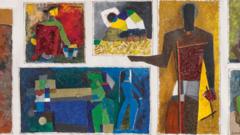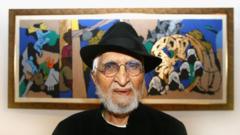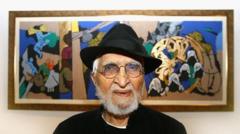The remarkable auction of MF Husain's 'Untitled (Gram Yatra),' sold for $13.8 million, shines a spotlight on India's cultural heritage and evolving art market.
**Historic Sale of MF Husain's Rediscovered Masterpiece Transforms Indian Art Landscape**

**Historic Sale of MF Husain's Rediscovered Masterpiece Transforms Indian Art Landscape**
A forgotten mural breaks records and headlines, revealing the enduring legacy of a modern art pioneer.
In a spectacular return to the limelight, a long-forgotten mural by acclaimed Indian artist MF Husain has rewritten art history, selling for a staggering $13.8 million (£10.6 million) at a recent Christie's auction in New York. This remarkable painting, titled 'Untitled (Gram Yatra),' now holds the record for the highest price ever fetched by an Indian artwork, eclipsing the previous record of $7.4 million (£5.7 million) set by Amrita Sher-Gil's 'The Story Teller' in 2023.
Husain, who passed away in 2011 at the age of 95, is widely regarded as a trailblazer of Indian modernism. His impressive journey started with a migration from India in 2006, driven by threats from extremist factions over his bold artistic representations. The rediscovery of 'Gram Yatra' is both startling and illuminating, as for nearly fifty years, this 14-foot mural remained an unnoticed treasure within the walls of a Norwegian hospital.
Painted in 1954, 'Gram Yatra' encapsulates the essence of Indian village life through a series of 13 vignettes showcasing both the simplicity and richness of rural existence. Husain's signature style, a harmonious blend of traditional Indian folk art and modernist influences, finds expression in scenes of women cooking, caring for children, and engaging in agricultural labor.
Nishad Avari, head of South Asian Modern and Contemporary Art at Christie's, described the mural as the quintessential piece representing modern South Asian art. The painting is characterized by rich, earthy tones and a narrative quality that echoes India's fine miniature art tradition. Husain’s travels, particularly a significant trip to China in 1952, profoundly influenced his artistic technique, as seen in the expressive brushwork that defines this piece.
Husain’s biographer, Akhilesh, emphasizes that the artist's profound connection with India's cultural heritage profoundly shaped how the nation’s identity was perceived. Moreover, 'Gram Yatra' also signals the first appearance of Husain's innovative cubist style, marked by dynamic geometric shapes and bold lines.
The journey of this exceptional piece, originating in Delhi and serving as a decorative staple in Oslo University Hospital for decades, added to its gripping narrative. It came into the ownership of Ukrainian doctor Leon Elias Volodarsky during a 1954 WHO mission in India for only $295, remaining below the radar of the global art community until it was brought to Christie's attention in 2013 after Husain’s death.
Art market experts like Ashish Anand predict that this landmark sale will positively affect the valuation of Husain's broader body of work and illustrate the shift of Indian art toward a serious and significant financial investment rather than merely aesthetic appreciation.





















